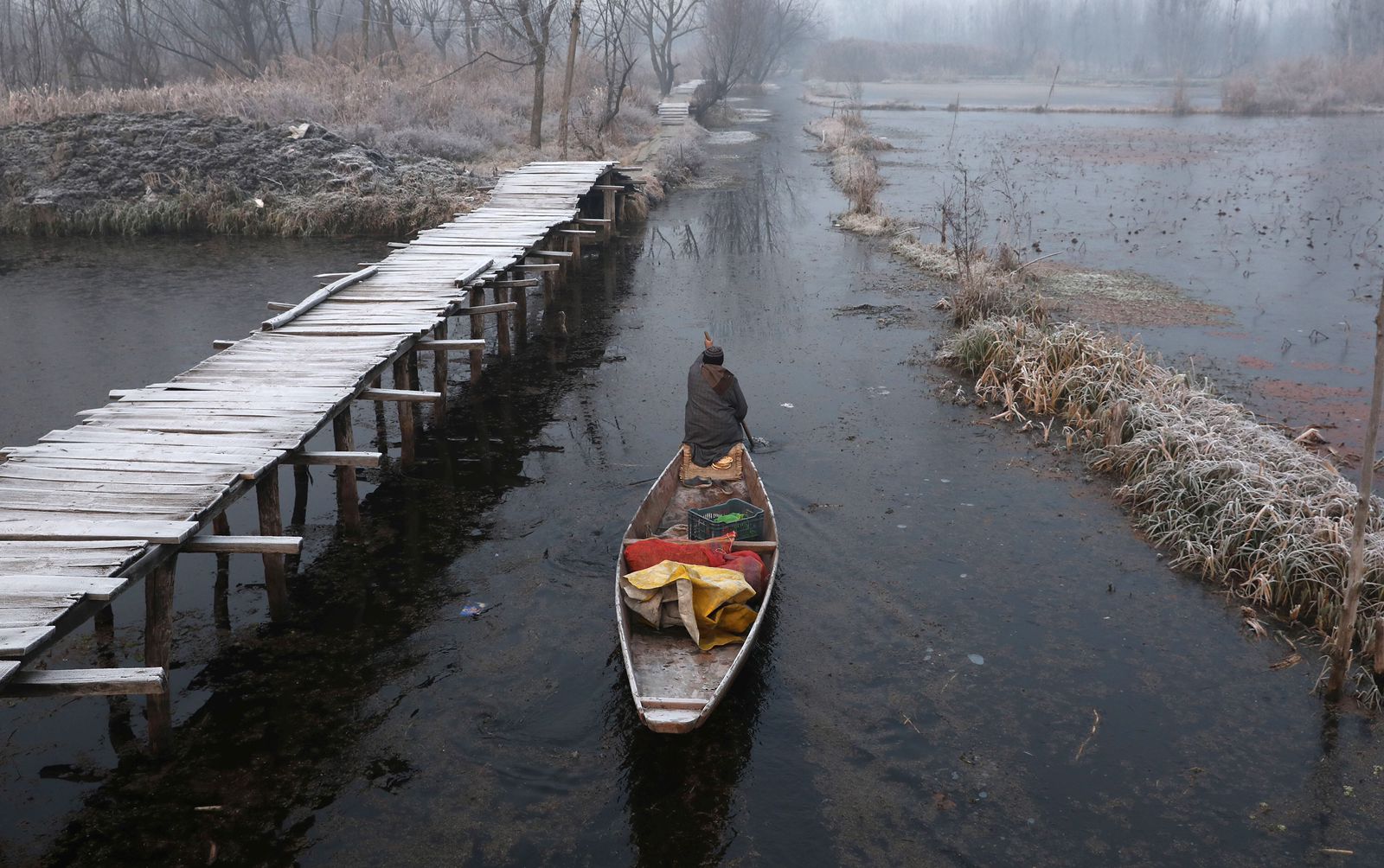La Niña Arrives: Kashmir Braces for an Intense Winter
By: Javid Amin | 07 October 2025
The chill has come early to the Himalayas — and more is on the way. Meteorologists have confirmed the return of La Niña, a global climate pattern expected to shape India’s weather between October and December 2025.
In the Kashmir Valley, the impact could be especially pronounced. Experts predict colder temperatures, heavier snowfall, and longer frost spells than in typical years — putting pressure on power grids, travel infrastructure, farmers, and tourism operators alike.
The first signs are already visible: fresh snow has dusted Gulmarg and Sonamarg in early October, weeks ahead of schedule.
“La Niña could amplify Kashmir’s winter intensity this season. We’re advising early preparedness for both households and institutions,” said a senior official at the India Meteorological Department (IMD), Srinagar.
What Is La Niña and Why It Matters
La Niña is the cooler sibling of El Niño. It occurs when sea surface temperatures in the central and eastern Pacific Ocean drop below average, which in turn triggers shifts in global wind and pressure patterns.
For India, the effects are well-documented:
-
🌡 Colder winters in the northern states and Himalayan regions.
-
❄️ Increased snowfall in hill stations such as Gulmarg, Pahalgam, and Sonamarg.
-
🌧 Delayed monsoon retreat and lingering wet spells.
-
🌫 Denser fog and higher frost frequency, particularly in December and January.
Climatologists note that La Niña winters often last longer, with more intense cold waves across North India.
Also Read | Must-Visit Waterfalls in Kashmir 2025 – Nature’s Hidden Gems
Kashmir’s Winter Outlook 2025: Snowy, Prolonged, Unforgiving
❄️ Early Indicators
-
Early October snowfall recorded in Gulmarg and Sonamarg.
-
Sharp temperature drops (as much as 13 °C) reported across the Valley.
-
Road closures already affecting Mughal Road and National Highway 44 (NH-44).
These are classic La Niña precursors: an early onset of winter conditions.
🧊 Forecast Highlights
-
More frequent snow spells in November and December.
-
Longer frost periods extending deep into January.
-
Temperature drops below average — day temperatures may hover 4 – 6 °C lower than normal.
-
Increased precipitation, especially at higher altitudes.
IMD scientists caution that this winter could test infrastructure resilience, with ripple effects across sectors.
Tourism: A White Canvas with Two Faces
Tourism is often the first to feel winter’s touch — both the magic and the mayhem.
✨ Opportunity Wrapped in Ice
Snowfall is Kashmir’s most powerful tourism magnet. Already, tour operators like JKL Travels have launched early snow-viewing and ski packages, anticipating a longer winter travel season.
-
Ski resorts in Gulmarg preparing to open early.
-
Higher bookings for heated accommodations.
-
Surge in winter gear rentals and curated honeymoon itineraries.
“If La Niña brings more snow, it’s a visual treat. But infrastructure must keep pace,” says Javid Amin, founder of JKL Travels.
⚠️ The Logistical Chill
However, heavy snowfall also brings travel hurdles:
-
❌ Possible flight delays at Srinagar International Airport.
-
🚧 Road closures along Mughal Road and NH-44.
-
🏨 Disruptions in supply chains for hotels and resorts.
To capitalize on La Niña’s snow bounty, tourism stakeholders need early planning, flexible bookings, and better connectivity.
Also Read | Kashmir Honeymoon Packages 2025 – Romance in Paradise
Local Life: Heat, Health, and Hustle
La Niña winters affect not just tourists but daily survival in Kashmir’s towns and villages.
🔥 Heating Demand Surge
As the mercury dips, power demand soars. The Kashmir Power Distribution Corporation Limited (KPDCL) is already preparing for peak load management. Rolling power cuts, common in harsh winters, could stretch longer if demand outpaces supply.
Households are rushing to:
-
Install or service bukhārīs (traditional wood/coal heaters).
-
Buy extra blankets and thermal wear.
-
Arrange alternate heating sources like gas and solar units.
🩺 Health Risks Rise
Cold weather, especially when prolonged, heightens respiratory illnesses, flu outbreaks, and cases of hypothermia — particularly among children and the elderly. Hospitals are on alert for:
-
Chest infections
-
Asthma and COPD flare-ups
-
Winter-related injuries from slips and falls
“We’re expecting more cold-related admissions this season if La Niña stays strong,” said a physician at Sher-i-Kashmir Institute of Medical Sciences.
Agriculture & Rural Economy: The Frost Threat
Kashmir’s agriculture and horticulture sectors are particularly vulnerable to early and prolonged cold.
🍎 Apple & Orchard Crops
In Shopian district, Kulgam, and Pulwama, many apple orchards are still in late harvest. An early frost can damage unpicked fruit, bruise post-harvest produce, and reduce market value.
🌸 Saffron Fields
In Pampore, Kashmir’s saffron capital, La Niña’s chill may affect flowering cycles. Prolonged frost can damage bulbs and lower yields.
🥬 Vegetables & Greenhouses
Rabi crops and greenhouse vegetables also face frost risk. Farmers are being advised to use mulching, low tunnels, and straw covers to protect sensitive crops.
IMD and agricultural departments are rolling out frost advisories earlier than usual this year.
Infrastructure Under Pressure
Kashmir’s winter backbone is its roads, highways, power lines, and communication networks. La Niña will strain all of these.
🏔 Mughal Road & NH-44
Snowfall has already forced the closure of Mughal Road at Pir Ki Gali. NH-44 — the lifeline between Jammu and Srinagar — has seen landslides and traffic delays around Ramban, Banihal, and Qazigund sectors.
Snow clearance and landslide mitigation will be critical to keep Kashmir connected.
⚡ Power Grid & Communication
Early snow can damage power lines, trigger transformer failures, and disrupt mobile connectivity. Load-shedding is almost inevitable.
🏥 Healthcare & Transport
Ambulance access, patient transport, and essential supplies can all be affected during snow spells — underscoring the need for winter contingency plans.
Also Read | Kashmir Tour Packages 2025 – JKL Travels Exclusive Mega Deals
Climate Science: La Niña and the Himalayas
La Niña’s influence on India is well studied — but its regional impact on the western Himalayas is gaining renewed scientific attention.
-
Cooler Pacific waters strengthen monsoon withdrawal winds.
-
Moisture-laden air masses from the Arabian Sea interact with Western Disturbance systems.
-
This enhances snowfall over Kashmir and Himachal Pradesh.
-
It also prolongs cold spells, delaying the onset of springlike warmth.
Climatologists warn that climate change may amplify these oscillations, making extreme winters more frequent.
“The Himalayas are highly sensitive to Pacific climate signals. La Niña winters are a reminder of how globally connected weather really is,” explains a researcher from Indian Institute of Tropical Meteorology.
Preparedness: What Kashmir Can Do Now
🏡 For Households
-
Service heating systems early.
-
Stock up on essentials — fuel, dry goods, medicines.
-
Check insulation to reduce energy use.
-
Keep emergency lighting and chargers ready.
🏢 For Authorities
-
Pre-deploy snow clearance machinery on key routes.
-
Stock transformers, poles, and repair equipment.
-
Issue real-time road and weather updates.
-
Strengthen hospital emergency readiness.
🧳 For Tourism Operators
-
Offer flexible booking and refund policies.
-
Coordinate transport, guides, and accommodations.
-
Train staff in snow safety protocols.
-
Prepare backup itineraries if roads close.
🌾 For Farmers
-
Harvest apple crops promptly.
-
Protect saffron bulbs from frost.
-
Use low-cost insulation to shield vegetable crops.
-
Follow IMD frost alerts closely.
Also Read | Top 7 Places to Visit in Srinagar for First-Time Travelers (2025 Guide)
Social Media Buzz vs. Ground Reality
Photos and reels of snow-laden Gulmarg chalets and white Sonamarg meadows are already flooding Instagram feeds. Hashtags like #KashmirSnowfall, #LaNinaWinter, and #Winter2025 are trending.
But on the ground:
-
Tourist numbers are rising slowly but cautiously.
-
Traffic police are issuing frequent advisories.
-
Local businesses are rushing to restock winter supplies.
-
Farmers are racing against time to save crops.
Snow may look magical online, but it comes with real-world complexities.
Economic Stakes
-
🏨 Tourism: High potential for extended season, but dependent on infrastructure and connectivity.
-
🧥 Retail: Demand surge for winter wear, heating products, snow boots.
-
🛣 Transport: Higher maintenance costs for roads and vehicles.
-
🌾 Agriculture: Significant frost risk for apples and saffron.
-
⚡ Energy: Higher power demand and grid stress.
A well-coordinated response can turn La Niña from a challenge into an opportunity.
Voices from the Valley
“We’ve started getting snow package inquiries earlier than ever. But people want assurance that roads will remain open.”
— Javid Amin, Travel Operator
“La Niña means colder nights and more power demand. We’re upgrading transformers and preparing load-management plans.”
— KPDCL Official
“The snow is beautiful, but our apples can’t handle early frost. We’re racing to harvest.”
— Farmer, Shopian
“La Niña years remind us how closely tied Kashmir is to global weather.”
— IMD Scientist
Also Read | Best Time to Visit Kashmir in 2025 – Month by Month Travel Guide
Climate Future: From Reaction to Resilience
The return of La Niña is not an isolated event — it’s part of a larger climate variability cycle. But with climate change in the mix, the intensity of these events is increasing.
Kashmir will need:
-
Winter-resilient infrastructure
-
Diversified tourism strategies
-
Climate-smart agriculture
-
Community-based adaptation plans
The earlier the Valley prepares, the more it can thrive in a colder future.
Final Word: Snowfall Is a Story — How We Write It Matters
La Niña’s chill will bring postcard-perfect moments to Kashmir. But beneath the white beauty lies a test: power stability, travel resilience, crop survival, and tourism adaptation.
Nature is shifting its rhythm. From households to policymakers, farmers to hoteliers — everyone must tune in.
The snow is coming early. The question is: will we be ready this time?




